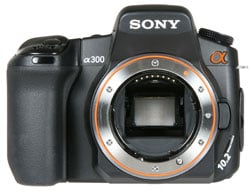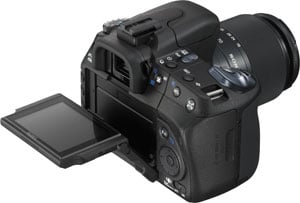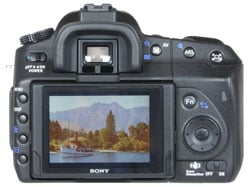Sony Alpha DSLR-A300
-
-
Written by Gordon Laing
Sony Alpha DSLR-A300 Verdict
Sony’s latest DSLRs, the A300 and A350, double the Alpha range and illustrate Sony’s commitment in the market. Indeed by discontinuing the original A100 and introducing four brand new models in as many months, Sony has been more aggressive than any other DSLR manufacturer.
 |
Unlike rival manufacturers, Sony is also interestingly now applying the same strategy to its DSLR range as it has with compacts for years – that is, producing a base model (in this case the A200), then simply adding new, ‘up-selling’ features to subsequent models in the range. So the A300 takes the A200 and adds Live View along with a vertically tiltable monitor. Then the A350 takes the A300 and swaps its 10.2 Megapixel sensor for one with 14.2 Megapixels.
While this certainly allows buyers to go for the exact features they want, it’s a well-known strategy for securing greater shelf space in retailers, not to mention providing an easy path for up-selling to the priciest model. Indeed it’ll be interesting to see how well this strategy translates into the DSLR market and whether every retailer – or indeed geographic region – takes all three models. And also which model will ultimately become most popular.
 |
Marketing strategies aside, what does the Alpha A300 offer? Sensor aside, the core specifications and features are identical to the higher-end A350. As such you get a feature-packed DSLR with built-in stabilisation, tilting screen and fast Live View facilities.
In terms of stabilisation, the built-in Super SteadyShot does a great job, offering three stops of compensation in our tests, although you won’t see the effect through the viewfinder – nor on-screen during Live View.
Speaking of which, unlike rival DSLRs which use their main sensor to deliver the Live View, Sony’s Quick AF Live View system in the A300 and A350 employs a small sensor in the viewfinder. A tilting mirror (also in the viewfinder) then directs the light to either the sensor or out through the optical viewfinder.
The major benefit to this system is the traditional AF system isn’t bypassed, so unlike most rivals, the A300 and A350 can autofocus in Live View at exactly the same speed as when composing with the optical viewfinder. There’s also none of the delay or noise as the mirror flips up and down. You can enter and exit Live View quickly and quietly, all while enjoying uncompromised AF performance.
In use it’s surprisingly quick and fuss-free compared to other Live View systems, but not without its downsides. The benefit of rival systems which use their main sensor for delivering Live View is the ability to see exactly what you’re getting: genuine 100% coverage, pixel-perfect magnified manual focus-assistance and a preview of any sensor-shift stabilisation, along with superimposed alignment graphics. By using a separate sensor in the viewfinder to deliver Live View though, the Sony A300 and A350 can’t offer any of this. The arrangement also compromises the optical viewfinder performance, which falls in magnification from 0.83x on the A200 to just 0.74x on the A300 and A350. That’s noticeably below other DSLRs.
The fact is though, the lack of mirror noise and image interruption, along with uncompromised auto-focusing speed will see Sony’s Quick AF Live View system preferred by most people, with only technical photographers finding it restrictive. And making Live View even more useful on the A300 is its vertically-tiltable 2.7in screen. Unlike the Panasonic Lumix L10, the Sony screen may not twist horizontally, nor is it able to face the front for self-portraits, but by allowing comfortable shooting over the heads of crowds or at low angles, the most important and useful positions are offered. It’s a great feature.
Other positive features include the friendly Function menu system, on-screen percentage battery meter, the ability to use not only the same battery as the A200, but also its optional grip, and crucially like all Alpha DSLRs, built-in sensor-shift stabilisation which works with any lens you attach.
Which finally brings us to the sensor and image quality. The only difference between the A300 and the A350 is the sensor – and its subsequent impact on continuous shooting. Once again, the A300 has 10.2 Megapixels and can shoot at 3fps (with the optical viewfinder), while the A350 has 14.2 Megapixels and shoots at 2.5fps. At first glance, the higher resolution of the A350 may seem more desirable, but by packing more pixels onto the same sensor area, noise levels should be worse. As such many enthusiasts hoped the A300 could in fact be the preferred model with the Live View and screen benefits of the A350, but sporting lower noise, smaller file sizes and slightly quicker continuous shooting to boot.
In reality this is true but not by a significant margin. In our tests, the A300 did deliver lower noise levels across its sensitivity range, but it certainly wasn’t a difference of night and day – and of course if the images from both cameras are reproduced the same size, the A350’s artefacts will be smaller. Had the A300 performed as well as the best 10 Megapixel DSLRs out there in terms of noise levels, then it would have been a decent step-up from the A350 in this respect, but by sharing the same sensor as the A200 and A100, it was already worse-off than several key models. The Canon EOS 400D / XTi and Nikon D80 for example deliver lower noise at higher sensitivities than the A300.
So while the A300 does have slightly lower noise levels than the A350, it’s not by a huge margin, and crucially, it was already higher than the competition to start with. If you’re already familiar with the A100 or A200 though, you’ll know what you’re going to get. So before wrapping-up, how does the A300 compare to the competition?
Compared to Sony Alpha DSLR-A200
We’ll start with the entry-level model in the Alpha range, the DSLR-A200. As explained above, the A200 is effectively the base upon which the A300 and A350 add features. So essentially there isn’t anything the A200 has which the A300 hasn’t – apart from a slightly bigger viewfinder magnification and differently styled grip. By sharing the same sensor and image processing, the A200 and A300 have identical image quality and continuous shooting speeds, so the choice between them really depends on how much you want Live View and the tilting monitor. The Live View is certainly much quicker than rival models and the tilting screen allows creative compositions, but the downside is compromising on the size of the optical viewfinder. If you’re not bothered about Live View or a tilting screen, then the Alpha A200 remains a great entry-level DSLR. See our Sony Alpha DSLR-A200 review for more details. |
Compared to Sony Alpha DSLR-A350
The next obvious comparison is of course against Sony’s Alpha A350. This is the closest model to the A300, with the only difference being sensor resolution, continuous shooting speed and price: the A300 has 10.2 Megapixels and shoots at 3fps, while the A350 has 14.2 Megapixels and shoots at 2.5fps. The lower resolution sensor makes the A300 slightly cheaper, but otherwise, they are identical. On the surface it would therefore simply appear to be a choice of paying more for a higher resolution sensor – albeit with a slight compromise in continuous shooting if you opted for the A350. But packing more pixels onto the same sized sensor has resulted in higher noise levels on the A350, but not by such a significant margin that the A300 is a natural choice for low light enthusiasts. By sharing the same sensor as the A200 and A100, the A300 already has higher noise levels than many rival 10 Megapixel DSLRs, so don’t buy it assuming it’s a big step-up from the A350 in this respect – see our A300 noise results pages for more details. Anyone deciding the A350 is the camera for them though should be aware its 14.2 Megapixel sensor is out-resolving the DT 18-70mm kit lens, so to see any benefit of its high resolution, you’ll need to upgrade the lens to a better model like the Sony DT 16-80mm. See our Sony Alpha DSLR-A350 review for more details |
Compared to Sony Alpha DSLR-A700
With Live View and a tilting screen, the new A300 appears to trump some aspects of the existing Alpha flagship, the A700. But there’s many more factors to take into account. The A700 is bigger, tougher and faster, boasts 5fps continuous shooting, 12.2 Megapixel resolution, HDMI output, a bigger viewfinder magnification, and a screen which may not tilt, but is bigger at 3in, and much more detailed with VGA resolution. In the favour of the A300 are Live View, a tilting screen and lower price. Ultimately higher-end enthusiasts and semi-professional photographers will still prefer the A700, but the A300, and especially the higher resolution A350 certainly give buyers plenty to weigh-up. See our Sony Alpha DSLR A700 review for more details. |
Compared to Canon EOS 450D / Rebel XSi
Canon’s EOS 450D / Rebel XSi is likely to be a big rival to the Sony A300. Despite the higher price of the Canon, the Sony A300 stacks-up well in terms of features, with a tiltable screen, quicker AF in Live View, and built-in stabilisation which works with any lens you attach. And the Sony kit lens is slightly longer too, zooming into 70mm compared to the Canon’s 55mm. In its favour, the Canon 450D / XSi has two extra Megapixels, a slightly bigger 3in screen (albeit fixed in position), quicker 3.5fps continuous shooting, 14-bit image processing, a bigger viewfinder, mirror lockup, a depth-of-field preview button, and a Live View mode which may be slower, but features both a contrast-based AF option and a true preview of what you’ll be capturing from the main sensor. You also get PC remote control software which includes a live on-screen preview. It’s a tough one to weigh-up, but the Alpha A300 arguably has the edge for general buyers while the 450D / XSi will probably appeal to the more technically demanding photographers. See our Canon EOS 450D / Rebel XSi review for more details. |
Compared to Olympus E-510
The Olympus E-510 was one of the most feature-packed DSLRs of 2007 and heavy discounting means it remains one of the best buys in the market. Like the A300, the E-510 has Live View and built-in sensor-shift stabilisation which works on any lens you attach. In its favour, the E-510’s SuperSonic Wave Filter is the best anti-dust system we’ve tested, and while it may not eliminate all foreign particles, it does a great job of making them virtually impossible to see. And while its built-in stabilisation may not be visible through the optical viewfinder, unlike the Sony A300, it can be previewed on-screen. By using the main sensor for Live View, you’ll also see an exact preview of what you’re taking. In its favour, the A300 has quicker AF in Live View, a tiltable screen which is also bigger at 2.7in, and a slightly longer 18-70mm kit lens. But while the E-510 may be out-featured in these respects, there’s no arguing with its bargain price, especially with the twin lens kit which simply offers remarkable value right now. See our Olympus E-510 review for more details. |
Other models to consider
There’s only so many comparisons we have room for on this page, but other models worth considering are the Canon EOS 400D / XTi, Nikon D60 and the Pentax K200D.
Sony Alpha DSLR-A300 final verdict
The Sony Alpha A300 is a feature-packed DSLR with a compelling price tag. With built-in stabilisation, Live View and a flip-out screen, it ticks the boxes of most new DSLR buyers. Sony’s fuss-free Live View is also arguably the best implementation yet for general consumers. It’s quick, quiet and offers uncompromised auto-focusing performance. Sure the coverage and accuracy isn’t the same as systems which use the main sensor, but this will only bother the more technical photographers out there.
 |
In general use the A300 handles very well, and is a highly enjoyable camera to use in practice. You find yourself regularly switching between the optical viewfinder and Live View with a quick and simple switch, and exploiting the tilting screen for unusual angles.
Like the A200 before it, the menus are easy to navigate and the Function presentation provides easy access to the key settings. Meanwhile, the large chunky buttons are easy to operate even when gloved which will be appreciated by anyone shooting in colder conditions.
Like the A350 before it though, technical photographers may find sufficient issues to make it a deal breaker. The Live View may be quick and fuss-free, but by not delivering 100% coverage, superimposed gridlines or magnified manual focus assistance, it’s not as useful for precision work like astro or macro photography. The relatively small viewfinder will also disappoint those who’ve used other DSLRs.
There was also a hope the A300’s lower resolution sensor would significantly out-perform the A350 in terms of noise levels, but that’s sadly not the case. In our tests it certainly delivered lower noise across the sensitivity range, but not be a large degree, and again, by sharing the same sensor as the A200 and A100, its noise levels were already beaten by many rival 10 Megapixel DSLRs to start with. So once again, don’t buy the A300 believing it’s a low-light leader.
So when considering the A300 you have to think very carefully about what kind of photographer you are. If you’d find the Live View system restrictive, the viewfinder small, or the noise levels not to your satisfaction, then you’ll be better off with something else, like the Canon 450D / XSi – or even the Canon 400D / XTi if you don’t need Live View. But if these aspects don’t bother you, then the Alpha A300 is a great choice.
If you’ve fallen for Sony’s Live View system and tilting screen, the big question then is whether to go for the A300 or the A350. If you’re only going to use the kit lens, then we’d say save yourself some money and buy the A300, as the A350 needs better optics to exploit its higher resolution; fit them both with the kit lens and the A350 has little discernable advantage in real-life situations.
That said, if you are budgeting for better optics, the A300 still remains a compelling option. If 10 Megapixels are enough – and they are for most of us – then the A300 will give you smaller file sizes and slightly quicker continuous shooting with money spare for accessories. Fit it with a decent lens like the Sony DT 16-80mm and you’ll again see an upgrade in resolved detail. So for our money, unless you absolutely need 14 Megapixels, the A300, despite not offering significantly better noise levels, is probably a better bet than the A350 overall. When weighing up these cameras though, do look outside the Sony brand and compare with other models as you may find one which better suits you overall.
|
So despite a few issues which will annoy technical photographers, the Alpha A300 is a strong DSLR with great features and arguably one of the best Live View implementations to date. Its lower price than the A350 also makes it better value and a sensible choice for anyone who wants a Sony DSLR but doesn’t need 14 Megapixels.
Bad points | Scores (relative to 2008 budget DSLRs) |
 | ||
Build quality: Image quality: Handling: Specification: Value:
Overall: | 17 / 20 17 / 20 18 / 20 17 / 20 18 / 20
87% | |||









